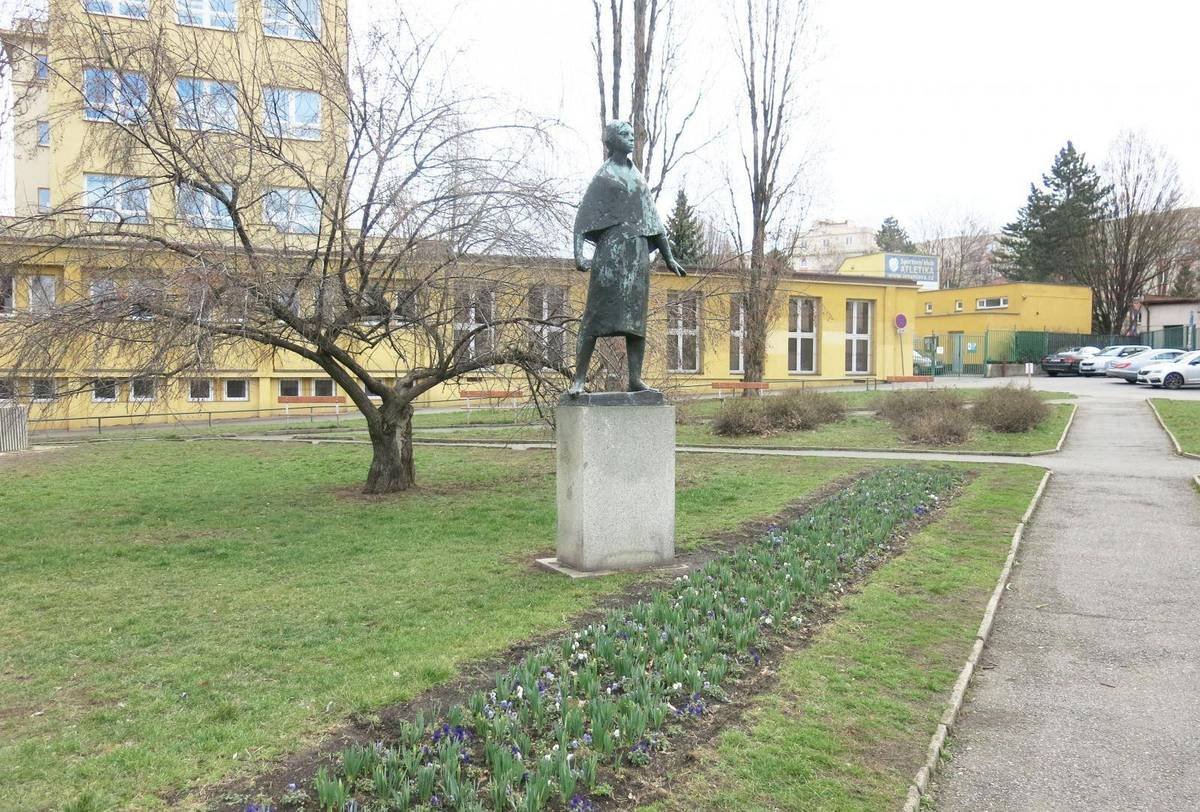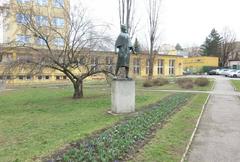
Complete Guide to Visiting the Statue of Anna Proletářka in Prague, Czech Republic
Date: 14/06/2025
Introduction
Nestled in the vibrant Žižkov district of Prague, the Statue of Anna Proletářka stands as a striking testament to Czechoslovakia’s turbulent 20th-century history and the artistic movement of Socialist Realism. Erected in the mid-20th century, this monument embodies the ideals of the working class, visually narrating the regime’s vision of social progress through the iconic figure of Anna Proletářka—a symbolic female worker inspired by Ivan Olbracht’s 1928 novel. For visitors, the statue offers both an accessible encounter with Prague’s socialist past and an opportunity to reflect on public art’s power to shape memory and identity (Cultura Obscura; Courtauld Institute; Design Horizons).
Whether you are a history enthusiast, art lover, or a curious traveler, this guide will walk you through the statue’s historical significance, artistic features, practical visitor information, nearby attractions, and travel tips to help you make the most of your visit.
Table of Contents
- Historical Context: Czechoslovakia and Socialist Realism
- Artistic and Symbolic Features
- Social and Political Functions
- Reception, Legacy, and Contemporary Relevance
- Visitor Information
- Nearby Attractions
- Visitor Experience and Interpretation
- Frequently Asked Questions (FAQ)
- Summary and Final Tips
- References and Further Reading
Historical Context
Czechoslovakia and the Rise of Socialist Realism
After World War II, Czechoslovakia underwent dramatic transformation as the Communist Party consolidated power in 1948. The new regime sought to reshape society through Marxist-Leninist principles, and art became a tool for ideological education and propaganda. Socialist Realism, the official artistic doctrine imported from the Soviet Union, demanded that public art celebrate the working class, collective labor, and the leadership of the Communist Party (Courtauld Institute).
The Role of Public Monuments
Monuments like the Statue of Anna Proletářka were not merely decorative. They served as powerful tools of propaganda, intended to shape collective memory and reinforce the legitimacy of the Communist regime. These statues often commemorated revolutionary events, labor achievements, or symbolic figures such as Anna Proletářka, who represents the idealized female worker—an archetype meant to inspire women’s participation in the workforce and reflect the regime’s commitment to gender equality (Design Horizons).
Artistic and Symbolic Features
The Statue of Anna Proletářka is a quintessential work of Socialist Realist art. Typically cast in bronze, the statue depicts a robust woman in a dynamic, forward-moving pose—her attire simple, her physique strong, and her gaze resolute. Created in 1951 by sculptor Jan Lauda, the figure’s raised right arm and purposeful stride symbolize collective action, progress, and the unstoppable march of socialism (Cultura Obscura).
Key artistic elements include:
- Heroic Scale: The monument’s size and posture are intended to inspire awe and pride.
- Narrative Clarity: The statue’s accessible imagery avoids abstraction, making its ideological message clear to all viewers.
- Gender and Labor: Anna is both nurturing and assertive, embodying the dual roles of women as mothers and workers—central to the socialist vision of gender equality (Whites Writing Whiteness).
Social and Political Functions
Socialist Realist monuments like Anna Proletářka legitimated the Communist regime by linking it to ideals of progress and the well-being of ordinary people. They encouraged values such as diligence, solidarity, and loyalty. The statue’s focus on a female worker highlighted efforts to mobilize women as equal participants in building socialism—though, in reality, gender equality often lagged behind official rhetoric.
Reception, Legacy, and Contemporary Relevance
Following the Velvet Revolution of 1989 and the collapse of communism, the fate of such monuments was debated. Some were removed, others preserved as historical artifacts. The Statue of Anna Proletářka remains in its original location, serving as a focal point for reflection on the complexities of the past. Today, it is recognized for its historical and artistic value and is often included in educational programs and guided tours exploring Prague’s layered identity (Timeout Prague).
Visitor Information
Location & Accessibility
The statue is located in a public park in Prague’s Žižkov district, easily accessible by public transportation. Tram lines 3, 9, and 22 stop at nearby stations such as “Olšanské náměstí” and “Jičínská.” The area features level, paved paths suitable for wheelchair users, though some surrounding streets are cobblestoned (Mapy.cz).
Visiting Hours & Admission
As an outdoor monument, the Statue of Anna Proletářka is accessible 24/7, with no admission fee or ticket required. Daylight hours are recommended for optimal viewing and photography.
Facilities & Amenities
While there are no dedicated visitor facilities at the statue, cafés, shops, and public restrooms can be found within walking distance. For tourist information, consult the Prague Information Service (Frommer’s Visitor Information).
Guided Tours & Events
Numerous local tour operators offer walking tours focused on Prague’s socialist heritage, often including the Statue of Anna Proletářka. Occasional commemorative events related to labor history or International Women’s Day may take place at or near the site (Prague Experience; Prague.org).
Best Times to Visit
- Spring & Summer: Pleasant weather, lush surroundings, and long daylight hours.
- Autumn: Beautiful foliage and fewer crowds.
- Winter: Accessible year-round; dress warmly and use caution on icy paths.
Nearby Attractions
Enhance your visit by exploring other Žižkov landmarks:
- Žižkov Television Tower: Modern architecture with panoramic city views.
- Olšany Cemetery: The largest cemetery in Prague, with historical monuments.
- National Monument at Vítkov Hill: Significant for Czech national history.
- Local cafés and pubs: Experience Žižkov’s bohemian culture.
Use Mapy.cz to plan efficient routes and discover more Prague historical sites.
Visitor Experience and Interpretation
The Statue of Anna Proletářka provides a meaningful alternative to Prague’s more frequented landmarks. Its powerful presence invites reflection on the intersection of art, politics, and memory. While on-site information is limited, guided tours and travel apps like Audiala offer deeper context. Photography is encouraged, particularly in the morning or late afternoon for dramatic light.
Approach the monument with respect—do not climb on it or leave litter, and maintain a considerate noise level if near residential areas.
Frequently Asked Questions (FAQ)
Q: What are the visiting hours for the Statue of Anna Proletářka?
A: The statue is outdoors and accessible 24/7, but daylight hours are best for viewing and safety.
Q: Is there an admission fee or are tickets required?
A: No, visiting the statue is free of charge at all times.
Q: Is the statue wheelchair accessible?
A: Yes, paved paths lead to the statue, though some nearby streets may be cobblestoned.
Q: Are guided tours available?
A: Yes, several local operators offer guided tours focusing on Prague’s socialist heritage, including this monument.
Q: How do I get there by public transport?
A: Use tram lines 3, 9, or 22; stops “Olšanské náměstí” or “Jičínská” are nearby.
Q: Can I take photographs?
A: Absolutely. Early morning and late afternoon are best for lighting.
Summary and Final Tips
The Statue of Anna Proletářka is an evocative symbol of Prague’s socialist heritage, encapsulating the artistic, political, and social aspirations of mid-20th-century Czechoslovakia. Today, it invites visitors to engage critically with Prague’s history and the politics of memory. The monument is freely accessible year-round and easily reached by public transport, making it an essential stop for anyone interested in Prague historical sites or public art.
To enrich your visit, consider joining a guided tour, exploring nearby Žižkov attractions, and using travel resources like the Audiala app for immersive experiences. Respect the monument and its surroundings, and take time to reflect on the complex narratives it represents.
References and Further Reading
- Statue of Anna Proletářka in Prague: History, Visitor Information, and Significance, 2025, Courtauld Institute
- Statue of Anna Proletářka in Prague: History, Significance, and Visitor Information, 2025, Cultura Obscura
- Visiting the Statue of Anna Proletářka in Prague: Hours, Tickets, and Nearby Attractions, 2025, Frommer’s Visitor Information
- Statue of Anna Proletářka in Prague: History, Visiting Hours, and Cultural Significance, 2025, Whites Writing Whiteness
- Socialist Realism Architecture in Czechoslovakia: Origins & Impact, 2025, Design Horizons
- Visiting the Statue of Anna Proletářka in Prague: History, Significance, and Visitor Information, 2025, Lonely Planet
- Visiting the Statue of Anna Proletářka in Prague: History, Significance, and Visitor Information, 2025, The Historian Traveller
- Visiting the Statue of Anna Proletářka in Prague: History, Significance, and Visitor Information, 2025, Continent Hop
- Statue of Anna Proletářka in Prague: History, Visiting Hours, and Cultural Significance, 2025, Timeout Prague
For images and detailed location, consult the Wikimedia Commons category.























































































































































































